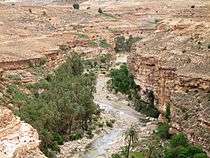Abiod Valley
Oued El Abiod (English: Abiod Valley) is a wadi that forms a mountain pass in the Aurès massif, located in the Saharan Atlas in northeastern Algeria.[3] Along with Oued Abdi, it is one of the most important wadis in the Aurès massif.[4] During the wet season, rain and melting snow flow into the valley to form the Abiod River. The valley begins at the foot of Djebel Chélia, Algeria's highest mountain, and flows southwest towards Tolga, eventually dissipating into the Sahara desert nearby.[3]
| Oued el Abiod Abiod Valley | |
|---|---|
 Abiod Valley near Ghoufi | |
| Native name | Ighzir Amellal |
| Physical characteristics | |
| Source | |
| • location | Djebel Chélia |
| • elevation | 2,000 m |
| Mouth | |
• location | Near Tolga, Biskra Province |
• elevation | 200 m |
| Length | 156 km |
| Basin size | 1,100 km |
| Basin features | |
| Tributaries | |
| • left | Oued Anza[1] |
| • right | Oued Chennaoura [2] |
Geography
The vegetation in the highlands on the north end of Abiod Valley is typically Mediterranean with dense forests of oaks, pines and ancient cedars, sustained by the plentiful rainfall on the higher slopes.[3] The southern part is mainly desert with very sparse vegetation, such as oak, juniper, cedar, clumps of thyme, and harmel.[5] The valley has several minor oases.
There are many human settlements along the walls of the Abiod Valley, including Ghoufi.[6][7] The sandstone walls of the valley are soft and easily worked into shape, so many villages on the valley's walls include extensive stonework buildings.[5] Near the town of Tighanimine, there is a remnant of an Ancient Roman irrigation canal.[8]
References
- Mitard, A-E (1941). "Aperçu des grands traits géographiques de l'Aurès, Algérie". Revue de Géographie Alpine. 29 (4): 557–578. doi:10.3406/rga.1941.4332 – via Persee.
- Busson, Henri (1900). "Les vallées de l'Aurès". Annales de Géographie. 9 (43): 43–55. doi:10.3406/geo.1900.6180 – via Persee.
- Scheffel, Richard L.; Wernet, Susan J., eds. (1980). Natural Wonders of the World. United States of America: Reader's Digest Association, Inc. p. 27. ISBN 978-0-89577-087-5.
- Kimble, George H. T. (June 1941). "The Berbers of Eastern Algeria". The Geographical Journal. The Royal Geographical Society (with the Institute of British Geographers). 97 (6): 337–347. doi:10.2307/1788169. JSTOR 1788169.
- Kimble 1941, p. 344.
- Tillion, Germaine (2000). Il était une fois l'ethnographie (in French). Seuil. p. 94. ISBN 9782020257022.
- Isguen-Bouzeis, Beni (1991). Encyclopédie berbère (in French). EDISUD. p. 1133. ISBN 9782857442011.
- Kimble 1941, p. 338.